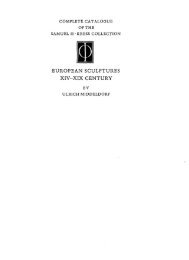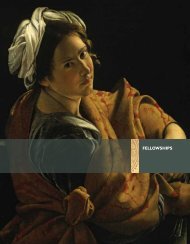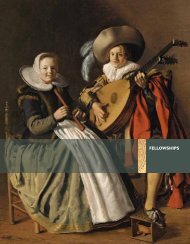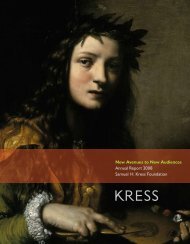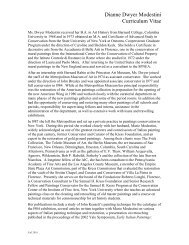The Campus Art Museum - Samuel H. Kress Foundation
The Campus Art Museum - Samuel H. Kress Foundation
The Campus Art Museum - Samuel H. Kress Foundation
Create successful ePaper yourself
Turn your PDF publications into a flip-book with our unique Google optimized e-Paper software.
Table 111.3. Gender of Research Participants<br />
Female (84) Male (46)<br />
<strong>Museum</strong> Directors 3 (43% of all directors) 4 (57%)<br />
<strong>Museum</strong> Staff 21 (78%) 6 (22%)<br />
Docents, Volunteers, Boards 9 (82%) 2 (18%)<br />
Students active in the <strong>Museum</strong> 27 (79%) 7 (21%)<br />
<strong>Art</strong>s Faculty 9 (56%) 7 (44%)<br />
Other Faculty and Administrators 15 (48%) 16 (52%)<br />
Note 1: Three more people were interviewed including an artist, a grade school teacher, and a recent alum and not<br />
included in this table. Two of these three are female.<br />
Note 2: <strong>The</strong>se figures reflect the interviewee population, not the total population of people in any category (other<br />
than museum directors) at the colleges/universities in the study.<br />
In a conversation where gender was discussed, a faculty member in art<br />
education raised the hypothesis that art is more “okay” for girls to pursue than for<br />
boys. She stated, “As a child I was always interested in art, in drawing, painting,<br />
making things, crafts. I was encouraged and allowed to go into art, I think, because<br />
I was a girl.” Similarly to the feminization of teaching, work as museum assistants,<br />
particularly educators, became deemed appropriate for females in the early 1900s<br />
(Kletchka 2007). Colleges for women such as Vassar and Wellesley began preparing<br />
young women as museum assistants and educators, and art history became a<br />
suitable subject for young women pursuing college degrees. In the first half of the<br />
twentieth century, women began playing important roles in museums, but after<br />
World War II, their positions often were replaced by returning veterans (Schwarzer<br />
2007). Women continued participating in the life of museums, but did so through<br />
volunteer associations, taking visitors through the museums and raising funds<br />
for museums through social galas (Schwarzer 2007). In the 1970s, women again<br />
began seeking professional positions in museums until, today, women make up<br />
almost two-thirds of all professional staff in museums (Schwarzer 2007). In difficult<br />
economic times, the professional jobs and programs cut first tend to be fields that<br />
have been “feminized,” occupations such as education and social work. <strong>Museum</strong><br />
curatorial and education positions risk similar cuts.<br />
“I love it when I hear a<br />
college student say, ‘I<br />
had no idea art spoke<br />
like this.’”<br />
Curator of Education<br />
<strong>Art</strong> Talk: How Participants Talk about the<br />
Meaning of <strong>Art</strong> & <strong>Art</strong> <strong>Museum</strong>s in their<br />
Lives<br />
<strong>The</strong> words captured, inspired, spoke, struck, and fell in love recurred in interviewees’<br />
responses to questions about their engagement with art. <strong>The</strong>y remember being<br />
struck by some work of art, stopped in their tracks, unable to move. <strong>The</strong>y describe<br />
ways that museum objects inspire them in their own art endeavors or in life in<br />
general. <strong>The</strong>y reflect upon how art helps them make connections, and how ideas,<br />
thoughts, or plans click into place. Many touch upon the power of art to move<br />
them; a few speak of personal revelations. In general, however, respondents find<br />
<strong>Art</strong> Talk: How Participants Talk about the Meaning of <strong>Art</strong> & <strong>Art</strong> <strong>Museum</strong>s in their Lives<br />
15



